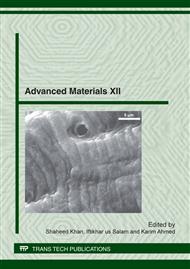p.454
p.461
p.467
p.475
p.481
p.487
p.493
p.500
p.507
Effect of Vanadium Addition to Aluminum and Aluminum Grain Refined by Titanium on their Chemical Corrosion Rate in Acidic Solution, HCL, at Different Temperatures
Abstract:
The paper presents the effect of vanadium addition to aluminum and aluminum grain refined by titanium on the micron level, in the range from 0.005 wt % to 0.236 wt %, on their corrosion resistance in acidic solution, HCl, at three different temperatures namely: 25 °C, 40 °C and 60 °C. It was found that the corrosion rate was slightly increased by the addition of any percentage of vanadium at 25 °C. Furthermore, it was found that the corrosion rate increased with the increase of temperature at any percentage of vanadium addition in the case of both aluminum and aluminum grain refined by titanium. However it was found that addition of vanadium at any percentage to either aluminum or aluminum+ titanium, resulted in decrease of the corrosion rate i.e. improvement in their corrosion resistance in acidic solution at 40 °C and 60 °C. The maximum achieved reduction in corrosion rate was 77 % at 40 °C and 0.148 wt % vanadium addition.
Info:
Periodical:
Pages:
481-486
Citation:
Online since:
May 2012
Authors:
Keywords:
Price:
Сopyright:
© 2012 Trans Tech Publications Ltd. All Rights Reserved
Share:
Citation:


